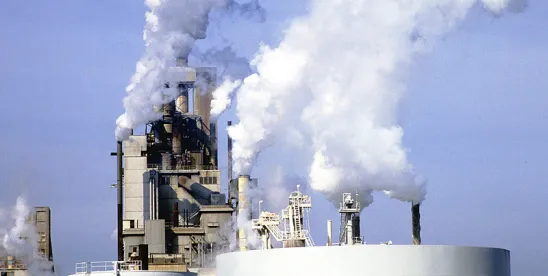Capping a dramatic but ineffective legislative session, Oregon Governor Kate Brown on March 10, 2020, issued Executive Order No. 20-04, “Directing State Agencies to Take Actions to Reduce and Regulate Greenhouse Gas Emissions,” which sets in motion potentially far-reaching administrative actions aimed at drastically reducing Oregon’s greenhouse gas (GHG) emissions over the next three decades. The Executive Order launches rulemaking proceedings for every Oregon agency with jurisdiction over GHG-related matters with the aim of reducing Oregon’s GHG emissions to 80 percent below 1990 levels by 2050.
Background: Oregon GHG Legislation and Attempts to Enact Cap-and-Trade
In recent sessions, Oregon has adopted several major bills seeking to reduce GHG emissions. These include, for example, a phase-out of coal-fired electricity, the Clean Fuels Program (Oregon’s version of the low-carbon fuel standard for motor fuels), legislation aimed at accelerating the adoption of electric vehicles, and legislation establishing a renewable natural gas portfolio standard. Oregon environmental advocates viewed economy-wide cap-and-trade legislation, which would impose a declining cap on GHG emissions and an emissions-credit trading system, as the capstone to these efforts. In both 2019 and 2020, Governor Brown introduced cap-and-trade legislation as a major item on her legislative agenda. Although the legislation appeared poised to pass in both sessions, aided by the tailwind of Democratic super-majorities in both legislative houses, the legislation was thwarted in both sessions by Republican legislators who walked out to deny a legislative quorum rather than see the legislation passed.
Executive Order No. 20-04: A Summary
Less than a week after the 2020 legislature adjourned without passing cap-and-trade legislation, Governor Brown issued Executive Order No. 20-04, which is aimed at creating a GHG program that exercises executive authority to the fullest extent permitted by existing legislation. The core mandate of the Executive Order is a GHG emissions reduction goal which aims to reduce Oregon’s GHG emissions to 45 percent below 1990 levels by 2035, and to 80 percent below 1990 levels by 2050. These goals are borrowed from Oregon legislation setting the state’s GHG reduction goals, although that legislation is clear that it creates no independent regulatory authority to achieve the goals.
The Executive Order applies to sixteen Oregon agencies, notably including the Oregon Public Utility Commission, the Oregon Department of Energy, the Oregon Department of Environmental Quality, and the Oregon Department of Transportation, and a range of agencies with responsibility for natural resources, including the Department of Forestry, the Department of Fish & Wildlife, and the Department of Agriculture.
The Executive Order directs all of these agencies to “exercise any and all authority and discretion” to achieve the order’s GHG reduction goals, and to “prioritize and expedite” action on GHG reductions “to the full extent allowed by law.” Each agency is required to report to the Governor on proposed actions by May 15, 2020. The Executive Order also includes a number of mandates aimed at specific agencies.
Department of Environmental Quality (DEQ): DEQ is directed to amend the Clean Fuel Standard to achieve a GHG reduction for motor fuels of 20 percent below 2015 levels by 2030 and 25 percent below 2015 levels by 2035. By comparison, the Clean Fuel Standard adopted by the Oregon legislature in 2009 requires a reduction of 10% below 2015 levels by 2025. The Executive Order also directs the DEQ to develop a method for utilities to aggregate clean fuel credits to advance Oregon’s established electric transportation goals.
DEQ is also assigned two potentially far-reaching tasks. First, it is directed to set caps and reduce GHG emissions from large stationary sources. Second, it is directed to regulate methane emissions from landfills consistent with “the most stringent standards” adopted in surrounding states. Finally, DEQ is directed to create a program to reduce food wastes and associated GHG emissions, with the goal of reducing food waste 50 percent by 2030. DEQ is required to submit a report to the Governor with a timeline for addressing these directives by May 15, 2020, with the goal of finalizing rules by January 1, 2022.
Oregon Public Utilities Commission (OPUC): While reaffirming the political independence of the OPUC, the Executive Order nonetheless directs the OPUC to incorporate six policy goals into its decision-making. These include two aimed at advancing decarbonization of the utility sector, two requiring the OPUC to address utility vulnerabilities to wildfire, one to encourage electrification of transportation consistent with Senate Bill 1044, and one requiring the OPUC and Oregon Housing and Community Services to address energy burdens and environmental justice issues.
Department of Business Services Building Codes Division (BCD): The BCD is directed to adopt building efficiency goals for new construction by 2030 that represent at least a 60% reduction in building energy use over 2006 levels. The BCD is also directed to compile a report documenting progress towards this goal in the code updates planned for 2023, 2026, and 2029, and to develop metrics for measuring that progress.
Oregon Department of Energy (ODOE): ODOE is directed to establish energy efficiency standards for ten different electrical appliances, ranging from portable spas to commercial dishwashers, by September 1, 2020. The standards are to match the most stringent among West Coast jurisdictions and are to be updated periodically so that they continue to match the most stringent standards among those jurisdictions.
Department of Administrative Services (DAS): The DAS, which provides auditing, financial, and acquisition services to Oregon’s state agencies, is directed to develop a model program for state agencies to acquire zero-emission vehicles as well as to support the “rapid conversion” of the state’s fleet to zero-emission vehicles and to expand charging infrastructure for public buildings. DAS is also directed to identify options for GHG reduction goals to be integrated into state contracting programs, and to provide a report to the Governor by September 15, 2020, detailing these options.
Transportation Directives: Oregon agencies involved in transportation (the Oregon Transportation Commission, Oregon Department of Transportation (ODOT), the Land Conservation and Development Commission, and ODOE) are directed to incorporate the GHG reduction goals set forth in the Executive Order into implementation of Oregon’s Statewide Transportation Strategy, with regular progress reports to be delivered to the Governor. In addition, the ODOT is directed to conduct a study of infrastructure needs for the electrification of Oregon’s transportation system, with an emphasis on rural areas. ODOT is also directed to develop a process for evaluating the GHG emissions impacts of transportation projects as part of its regular planning processes. ODOT is ordered to provide a report to the Governor on both the transportation electrification and GHG evaluation process by June 30, 2021.
Oregon Health Authority (OHA): The Executive Order requires the OHA to deliver a report on the health impacts of climate change in Oregon by September 1, 2020, with particular emphasis on low-income and rural communities, as well as Native American tribes. The OHA is also directed to study the mental health impacts of climate change and wildfire threats on Oregon’s youth, to be completed by June 30, 2021. Finally, OHA is directed, in conjunction with the Oregon Occupational Safety and Health Administration, to develop a proposal for workplace safety standards to protect employees from excessive heat and wildfire smoke. The proposal is to be delivered no later than June 30, 2021.
Global Warming Commission (GWC): The GWC must submit a proposal to the Governor by June 30, 2021, to establish state goals for carbon sequestration and storage in Oregon’s forest lands, wetlands, agricultural lands, and other lands with potential to store carbon. The GWC is also to provide progress reports on the state’s progress toward achieving the carbon reduction goals set forth in the Executive Order.
Executive Order No. 20-04: Implications
The Executive Order sets in motion a lengthy list of administrative actions that could have profound implications for Oregon industries. Because the Executive Order sets short deadlines for reporting and for initiating rulemaking processes, the next two to three years are likely to be marked by a flurry of intense activity at the agencies subject to the Order.
Actions taken after the close of the legislative session leave little doubt about the seriousness of the Governor’s actions. Shortly after the legislature adjourned, the Oregon Legislative Emergency Board, a legislative body created to address emergency situations arising when the legislature is not in session, acted to address a number of fiscal issues that were not addressed in the regular session. The Board included an appropriation of $5 million to the DEQ, which is intended to fund ten new positions created to draft rules for GHG emissions reductions.
Because DEQ has responsibility for what is likely to prove the most consequential of the Executive Order’s many directives, the new appropriation should help alleviate resource constraints that might otherwise inhibit the achievement of the Governor’s goals. For example, the Executive Order requires DEQ and other relevant agencies to submit a preliminary report to the Governor by May 15, 2020, regarding program options to cap and reduce emissions from large stationary sources, transportation fuels, and other liquid and gaseous fuels that can commence no later than January 1, 2022. It is likely that the program will include caps similar to those included in the failed cap-and-trade legislation, although it is unclear whether the emissions trading program included in the cap-and-trade bill will be part of the administrative rulemaking. For industry stakeholders, a key consideration of future carbon-related regulations will be whether or not such rules preempt local ordinances addressing carbon emissions. Further, because the Executive Order followed in the wake of failed legislation, and relies on existing statutory authorities, we anticipate extensive litigation regarding the extent to which the Executive Order, and the resulting administrative actions, exceed legislative authority.
In addition, the Executive Order is likely to produce new legislation that would be considered in future sessions of the Oregon Legislature. For example, the GWC report on carbon sequestration and storage may generate legislation that would be of great consequence for Oregon’s forestry and agriculture sectors.
In short, Executive Order 20-04 is likely to be one of the most consequential actions undertaken in Oregon to address climate change. As such, it bears careful scrutiny from anyone with significant interests in the Pacific Northwest.





 />i
/>i
